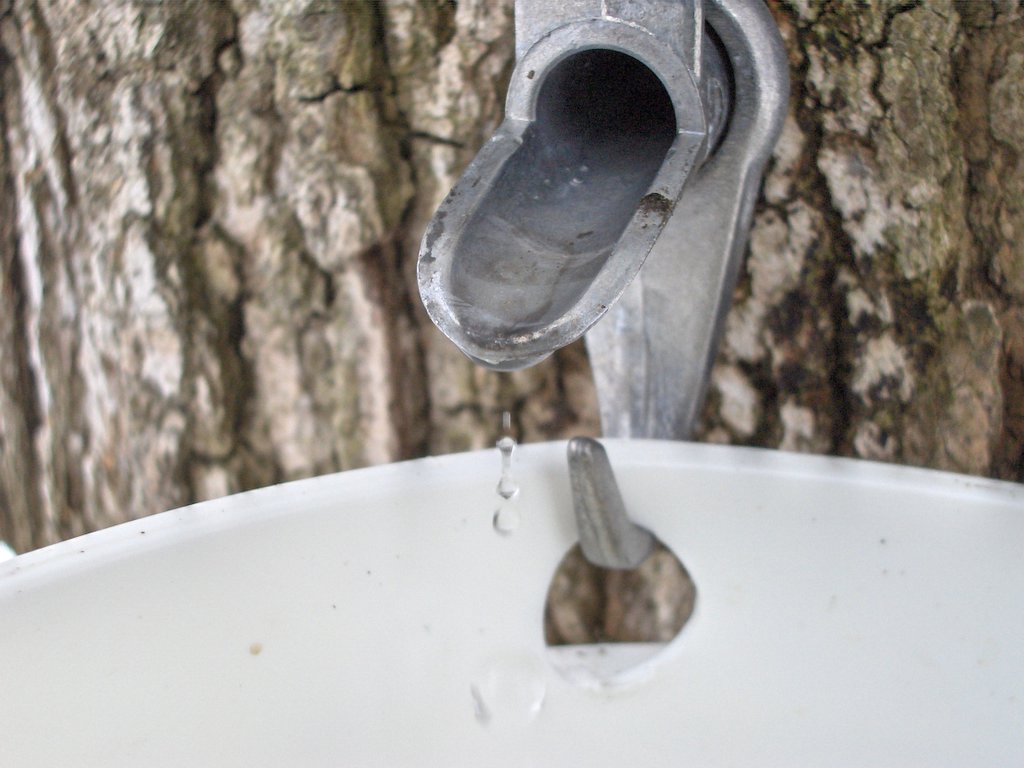A Big Year for Maple Syrup Producers
A chill spring means a lot of sap is running in Wisconsin.

Spigot tapping maple tree. File photo by bgilliard from St. Catharines, Canada, (CC BY-SA 2.0), via Wikimedia Commons
While some Wisconsinites are lamenting a spring that just won’t seem to arrive, the lingering cold weather has been sweet for the state’s maple syrup producers.
The maple syrup season in Wisconsin typically runs from mid-March to mid-April, but this year has been completely different, said Theresa Baroun, executive director of the Wisconsin Maple Syrup Producers Association.
For sap to run, Baroun said temperatures need to be freezing at night — ideally 20 to 25 degrees Fahrenheit — and just above freezing during the day — ideally 40 to 42 degrees.
If daytime temperatures reach 60 or 70 degrees, it can cause the trees to bud out which makes the sap unusable for syrup production.
But the cooler temperatures have held steady, right in the sweet spot.
“We had a short run in (the) beginning of March and then a second short run about the third week of March. And then everything stopped because it was too cold for production. And then about the first week of April, the trees, I guess you could say, woke back up and the sap produced like crazy,” said Baroun, who is also a producer in De Pere.
And with the longer timeline, Baroun said maple syrup producers across the state have had an above average season.
‘A banner year’
Jim Adamski’s family has been in the maple syrup business since 1984. At their certified organic sugarbush near Antigo, they tap 10,000 of their own trees and purchase sap from an additional 4,000 trees.
This year, Adamski said they tapped trees in early March and didn’t wrap up until April 18.
Adamski said they were able to produce around 5 pounds of maple syrup per tree — about 15 percent more than last year.
“Everything’s looking pretty fair in the maple world right now,” said Adamski.
And the story is no different up north.
Harvey Harrison is a third-generation maple syrup producer in Florence County. His grandfather purchased the 5,000-tap sugarbush in the 1890s and started making syrup in 1936.
In the decades since, the family has downsized to about 1,000 taps which they rotate each year.
In a typical year, Harrison said they make about 100 gallons of syrup. This year it was nearly double.
“This is a banner year,” Harrison said. “I got about 90 more gallons than I normally get.”
And Harrison said the colder weather not only brings more syrup, it brings better syrup.
“The colder weather makes lighter syrup because if the trees … heat up, that’s what creates the bacteria in your sap and then you make dark syrup,” Harrison said.
“This year was a really easy year to make good quality syrup,” Adamski said. “We had a limited amount of sunshine, the temperatures were relatively cool. We probably had 90 percent of our crop was golden, which is the best grade of syrup that you can possibly make.”
In addition to air temperature, the gradations are also influenced by the speed of processing and boiling time.
While smaller operations like Harrison’s tend to collect sap one day and cook the next, Adamski’s family prides itself on fast processing.
“We try to process whatever comes out of the tree on that day, you know, just to make the best quality that we possibly can,” Adamski said.
And with sap runs as bountiful as they were this year, Adamski said that meant cooking for 26 days straight.
But he said he lives by his grandfather’s advice: “If it isn’t boiling, it’s spoiling.”
‘Earlier and earlier’
With its bountiful supply of sugar maples — the state tree — Wisconsin ranks fourth in the United States for maple syrup production. Last year, the state produced 300,000 gallons of syrup.
Maple syrup production has a long history in Wisconsin and is rooted deeply in Indigenous subsistence practices. And the simplicity of the process brought a surge of hobbyist tappers during the pandemic.
“We definitely see a lot more, you know, changes in weather patterns, abrupt ends to seasons,” Adamski said.
In 2021, the season ended in March because the temperatures got so warm that the trees started to break dormancy. For some producers, the harvest lasted only three days, added Baroun.
And it’s all dictated by weather.
“What triggers trees to run is the highs and lows,” Harrison said. “When the weather is cruddier out and you’re constantly getting changes in the barometer, it tends to trigger the trees to drip more.”
But increasingly extreme swings in weather and warmer temperatures overall due to climate change are making for earlier and shorter maple syrups seasons.
“When you tap super early because of the weather, it’s usually a bad season,” Harrison said.
Some parts of southern Wisconsin experienced record warm spells in December, triggering trees to bud unusually early.
“Three of the last five years, our first runs of syrup were actually in February which is kind of rare for us,” Adamski said. “So, you know, we are starting to see some earlier runs.”
“It seems each year, the (season) gets earlier and earlier,” Baroun added.
Listen to the WPR report here.
‘Pretty fair in the maple world’: Cold spring weather means strong maple syrup harvest in Wisconsin was originally published by Wisconsin Public Radio.



















